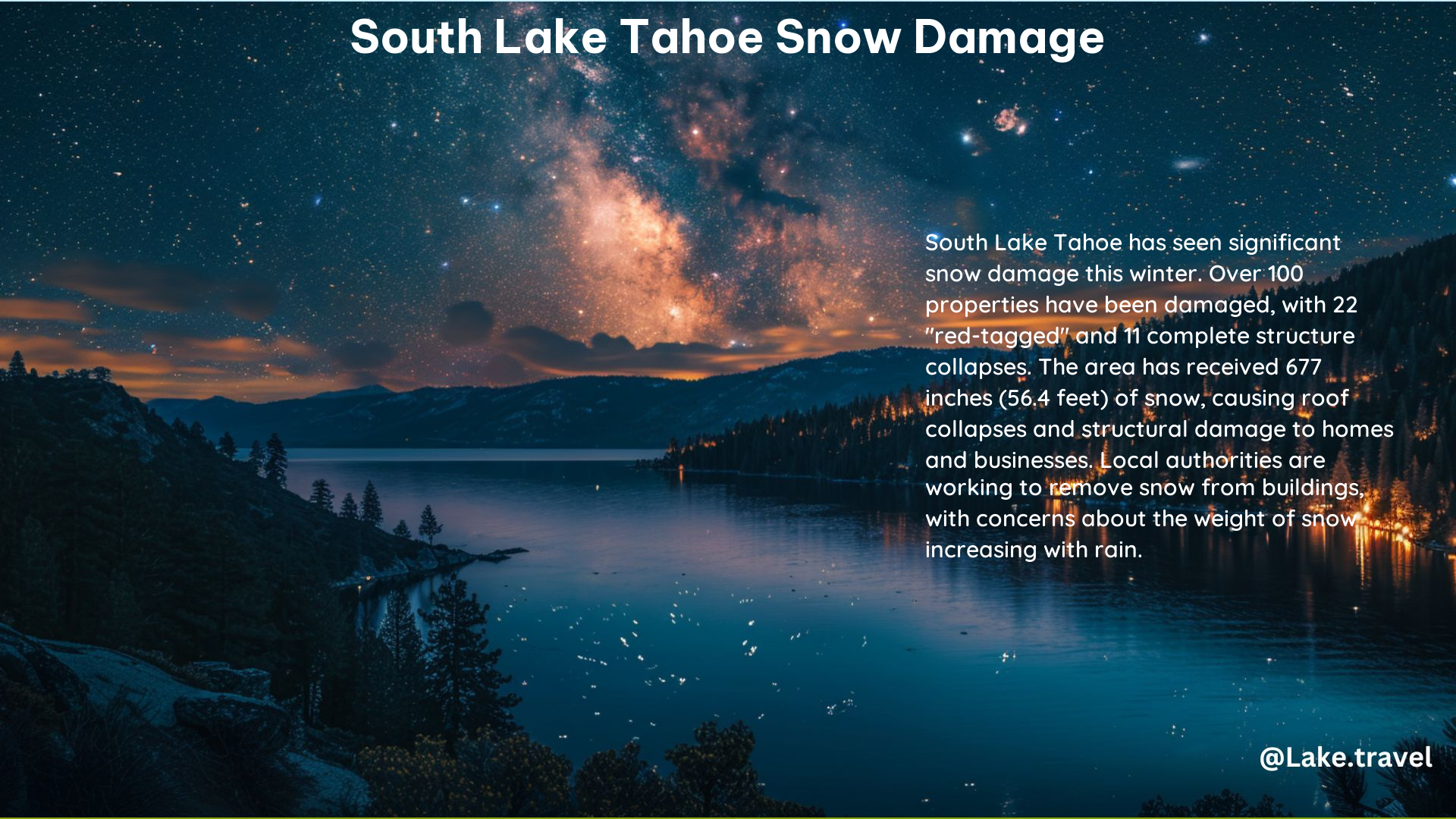South Lake Tahoe, a picturesque destination nestled in the Sierra Nevada mountains, has faced significant snow damage in recent years, particularly during the winter of 2023. From building collapses to roof damage, the city has had to grapple with the consequences of heavy snowfall, testing its resilience and preparedness.
Recent Instances of Significant Snow Damage
Building Collapses
- Melba Avenue Structure: A building on Melba Avenue suffered a roof collapse due to the weight of the heavy snow.
- Cold Creek Trail Home: A home on Cold Creek Trail experienced a partial collapse due to the snow load.
- Emerald Bay Road Gas Station: A gas station near Emerald Bay Road and 5th Street had its roof cave in, leading to a fire.
- Widespread Damage: Over 80 buildings near South Lake Tahoe were damaged, with 113 properties affected, 22 “red-tagged,” and 11 experiencing complete structure collapses.
Roof Damage
- Raley’s Grocery Store: The Raley’s grocery store on Lake Tahoe Boulevard had a partial roof collapse, and another Raley’s location was closed as a precaution.
- Residential Roof Collapse: A home within the city limits was reported to have partially collapsed due to the weight of the snow.
City Response and Snow Removal

Snow Removal Guidelines
- Recommended Snow Depth: The South Lake Tahoe Fire Rescue recommends removing snow when it reaches three feet high, but this can vary depending on factors like water content, roof slope, and structural capacity.
- Monitoring for Signs: Residents are advised to look for signs like sticking doors and ceiling cracks to determine if snow removal is necessary.
City Efforts
- Roof Load Requirements: The City of South Lake Tahoe and El Dorado County have minimum roof snow load requirements of 150 pounds per square foot, but each home’s capacity can differ.
- Clearing Public Buildings: Cal Fire and the California Conservation Corps have been working to remove snow from buildings with public benefits, such as schools and police stations, to maintain essential services.
Community Involvement
- Resident Responsibility: Residents are encouraged to shovel snow off their roofs or hire professionals to do so.
- Guidance from Fire Department: The South Lake Tahoe Fire Department provides guidance on safe snow removal practices.
These instances and guidelines highlight the importance of proactive snow removal and structural maintenance in South Lake Tahoe to mitigate the risks associated with heavy snowfall. By working together, the city and its residents can better prepare for and respond to the challenges posed by the region’s harsh winter conditions.
Factors Contributing to Snow Damage in South Lake Tahoe
-
Extreme Snowfall Levels: South Lake Tahoe experiences some of the highest snowfall levels in the United States, with annual averages exceeding 300 inches. This puts a significant strain on the structural integrity of buildings.
-
Aging Infrastructure: Many buildings in South Lake Tahoe were constructed decades ago, and their structural designs may not be equipped to handle the increasing snow loads.
-
Lack of Maintenance: Some property owners may neglect regular snow removal and roof maintenance, leading to the accumulation of heavy snow and eventual damage.
-
Topographical Challenges: The mountainous terrain surrounding South Lake Tahoe can create localized snow drifts and uneven snow distribution, making it difficult to predict and manage snow loads.
-
Climate Change Impacts: As the climate continues to change, South Lake Tahoe may experience more frequent and intense winter storms, further exacerbating the snow damage challenges.
Strategies for Mitigating Snow Damage
-
Proactive Snow Removal: Residents and property owners should regularly remove snow from roofs and structures to prevent the buildup of excessive weight.
-
Structural Assessments: Regular inspections and assessments of building structures can help identify potential weaknesses and guide necessary reinforcements or renovations.
-
Building Code Updates: The city and county may need to review and update building codes to ensure new constructions are better equipped to handle the region’s snow loads.
-
Community Preparedness: Educating residents on snow removal techniques, emergency response plans, and the importance of maintaining their properties can help the community be better prepared for winter storms.
-
Collaboration with Experts: Partnering with engineers, architects, and snow removal specialists can provide valuable insights and solutions to address the unique challenges faced by South Lake Tahoe.
By addressing these factors and implementing comprehensive strategies, South Lake Tahoe can work towards mitigating the impact of heavy snowfall and protecting its residents and infrastructure.
Conclusion
The snow damage experienced in South Lake Tahoe is a testament to the region’s harsh winter conditions and the need for proactive planning and preparedness. By understanding the specific challenges, engaging the community, and adopting innovative solutions, the city can build resilience and safeguard its residents and businesses against the consequences of heavy snowfall. As the climate continues to evolve, South Lake Tahoe must remain vigilant and adaptable to ensure the long-term well-being of its cherished mountain community.
Reference:
– South Lake Tahoe Building Collapses Due to Heavy Snow
– Roof Collapses in South Lake Tahoe Amid Heavy Snow
– South Lake Tahoe Residents Urged to Remove Snow from Roofs
